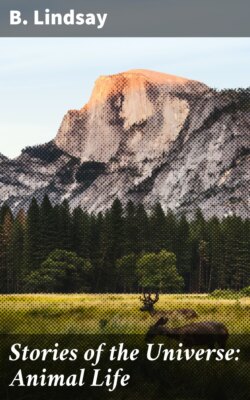Stories of the Universe: Animal Life

Реклама. ООО «ЛитРес», ИНН: 7719571260.
Оглавление
B. Lindsay. Stories of the Universe: Animal Life
Stories of the Universe: Animal Life
Table of Contents
PREFACE
THE STORY OF ANIMAL LIFE
CHAPTER I. THE STORY OF ANIMAL LIFE
CHAPTER II. HOW ANIMALS ADAPT THEMSELVES TO CIRCUMSTANCES
CHAPTER III. CLASSIFICATION, OR THE SORTING OF THE ANIMAL KINGDOM
CHAPTER IV. THE ONE-CELLED ANIMALS OR PROTOZOA
CHAPTER V. THE CŒLENTERATA
CHAPTER VI. THE SPONGES
CHAPTER VII. WORMS
CHAPTER VIII. ARTHROPODA, THE LOBSTERS, SPIDERS AND INSECTS
CHAPTER IX. MOLLUSCA, THE SHELL-FISH
CHAPTER X. THE BRACHIOPODA OR LAMP-SHELLS
CHAPTER XI. THE POLYZOA; MOSS-CORALS AND SEA-MATS
CHAPTER XII. THE ECHINODERMATA
CHAPTER XIII. THE CHORDATA
CHAPTER XIV. THE VERTEBRATA
CHAPTER XV. MAN
CHAPTER XVI. HOW ZOOLOGISTS DO THEIR WORK
INDEX
Отрывок из книги
B. Lindsay
Published by Good Press, 2021
.....
It may be added that the yellow Periwinkle is not only protected from mechanical sources of danger by its form, but is also in some degree protected from living enemies by its colour. This, at first sight, seems exceedingly conspicuous. We must remember, however, that the animal often lives in that part of the shore where the Bladder Seaweeds, or Fuci, are extremely abundant. The flowering ends of these are of a yellow colour, fairly bright. When seen from below, with the sunlight streaming through them, they no doubt appear much brighter than when seen, as we see them, from above, with the sunlight falling on them. Now protection from foes below is what the yellow periwinkle needs most: for fishes are quite ready to swallow it whole, and are not in any way deterred by the thickness of the shell, which is (by-the-way) in a measure a protection against birds when the tide is out; fishes habitually swallow shell-fish whole, although the inmate only is digested. The bright yellow, then, that seems to us so conspicuous, is probably a good means of hiding for the periwinkle when under water. Its common variations in colour, too, are probably protective in their use: some are a dull purplish brown, some drab. These are good colours in which to lie hidden, respectively, under darker tracts of seaweed, or upon the rock itself. This little shell is so abundant on rocky coasts that on some beaches the dead shells are as numerous as pebbles. No wonder, with all these adaptations for protection!
Another instance of adaptation to circumstances is described in the sea-urchin shown on p. 125. This is one among many instances where animals that live on sand or mud acquire a flattened shape, so that their weight is distributed, and the danger lessened, of their sinking in a quick-sand. The flat-fish, such as soles and flounders, are a familiar example; and the same principle is illustrated by the flattened forms of many of the bivalve shell-fish, whose flat shell, when closed, can lie safely on the loosest sand. Equally is their form adapted for their circumstances, when, in their slow way, they begin to move. For the flat valves of the shell are placed to the right and left of the animal's body. So that when it stirs, or floats quietly in the current of the tide, the shells present their sharp edges to the resistance of the water, thus enabling the creature to move like a ship through the sea, or like a knife-blade through bread, with the least possible friction: and specially is this provision for the lessening of friction important, when we consider that many of these bivalve shell-fish have to move, not only through water, but also through sand and mud.
.....